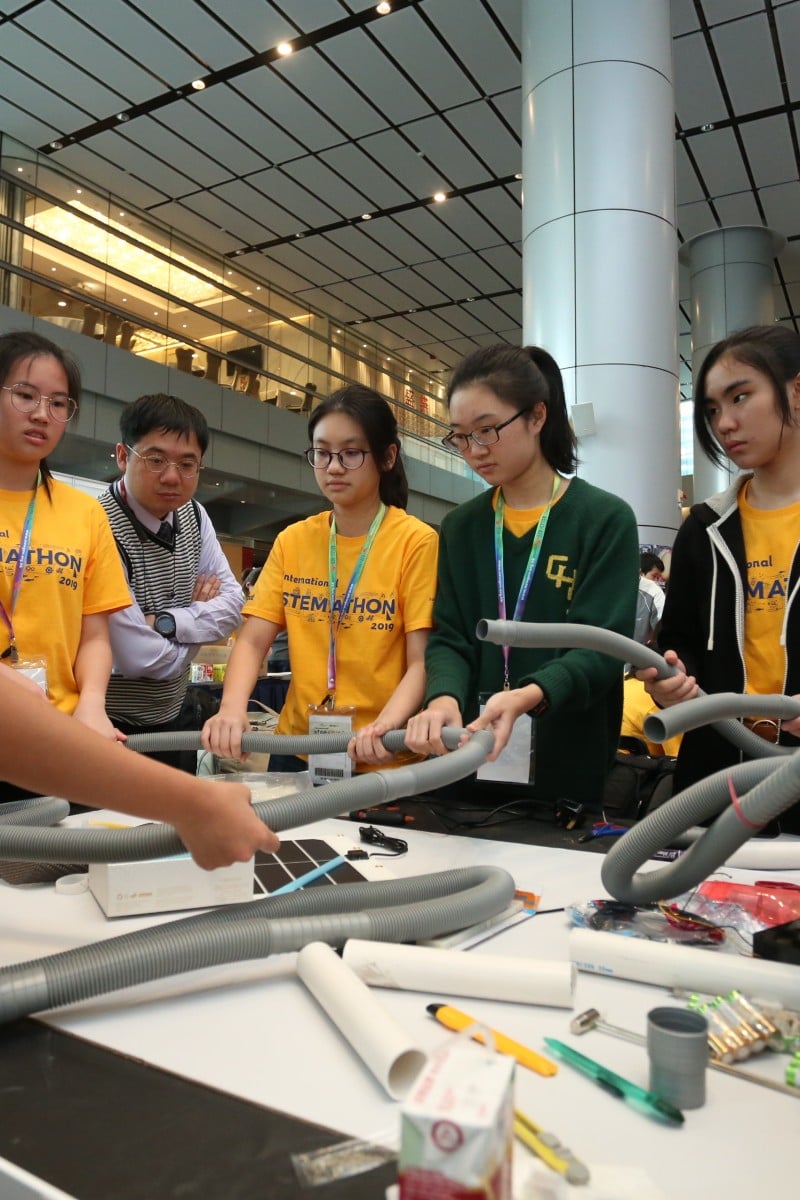 This team of students that came mostly from Good Hope School made a prototype to filter microplastics from seawater.
This team of students that came mostly from Good Hope School made a prototype to filter microplastics from seawater.Each year, local students team up with students across Asia at the Sun Life x Young Post International Stemathon 2019, which took place this year on March 28 and 29, to come up with viable solutions to real-life problems. This year’s theme was “Ocean Protection”.
The winning team was from St Margaret’s Co-educational English Secondary and Primary School. They created an automatic robot that collects plastic waste on beaches because they believe the rubbish left on beaches will end up in the sea.
“As oceans cover a lot of the area of the Earth and has the most diverse ecosystem, and since we are another inhabitant of Earth, we have the responsibility try our very best to protect it,” says Perry Law, 16, a member of the winning team. He adds he was surprised that his group won because they saw many other teams with amazing ideas.
One of those ideas came from the first runners-up from a team that were mostly students from Good Hope School. While the winning team’s robot quickly performs a task that humans can do, the team that came second focused on a material that is invisible to the human eye.
Microplastic pollution has become a widespread issue in recent years. There is a growing concern that the tiny plastic particles found in the world’s oceans are not only being eaten by fish and other sea creatures, but, because we are on top of the food chain, also by us.
One of the team’s members, Good Hope School student Stephanie Cho Sui-ching tells Young Post that marine pollution has a big impact on our daily lives. Seeing that, they invented a device that collect and destroy microplastics.
The group was inspired by an Instagram post about a rubbish bin designed to collect rubbish in the sea. “Rather than gathering rubbish, we thought we could change something and reduce microplastics instead,” Stephanie says.
In the 30 hours they were given, the team were able to build a prototype, which they made out of basic art and craft supplies, LED lights, and sound-emitting devices.
Here’s how it works: once the collector is placed in the sea, the water pump inside the collector would direct the seawater, together with the microplastics, into the machine. To prevent the machine from sucking in any unsuspecting marine animals, a bass speaker was installed under the collector that would emit sounds at 20 to 500 hertz (a measurement of audio frequency) to scare away animals.
After doing some research online about the advantages and disadvantages for different barriers to deter animals, they went with the speaker as it would cause less harm to sea creatures in the area.
The collected water would then flow into a conveyor belt made of nylon mesh filters, with holes that are 0.3 millimetres wide. The water that passes through the filter would go back into the sea through a pipe.
Any microplastics caught by the filter would travel down the belt and into a container. When the container becomes full, a sensor would turn on an attached GPS. This would then allow the collector to find its own way to a collection point where people could empty it out and put it back into use again. The motors on the machine that allow it to move and travel are powered by solar panels.
The team’s plan doesn’t end there. A 2017 report by a scientist found that wax worm caterpillars might be able to break down polythene into carbon dioxide instead of even smaller bits of plastic. That’s why the team said the final step in the process would be to use wax worm enzymes to convert the collected microplastics into water and carbon dioxide.
The team members did their best to make sure their machine didn’t cause harm to sea animals.
For example, the team did some online research about the advantages and disadvantages
about the different barriers they could use to keep animals away from their machine.
“Other measures, like [using] bright lights or an electrical barrier, would cause more damage to the fish and may even kill them,” explains fellow student Christy Fung Kai-tung, 15.
Christy recalls that one of the biggest challenges they faced was that they didn’t have enough time to stick every component of their prototype together for their presentation. “We thought it would still work if we just demonstrated our prototype, part by part,” she says, adding they hoped it would look as if they deliberately separated the prototype into smaller parts for a simpler, clearer showcase.
Moira Lopez, a fellow team member from the Philippines, says she’s always been interested in environmental conservation. She says that, as an agricultural country, the Philippines is directly affected by many environmental problems, but that people living in cities in other parts of the world should care, too.
We’re all in this ecosystem and the same circle of life,” says the 17-year-old.
“If we don’t look after our planet, in the long run, things are not going to look good.”
This event was sponsored by Sun Life Financial and organised by Young Post.
Edited by Nicole Moraleda
You might also like:
Talking Points: Should it be compulsory to recycle in HK?
What steps are you taking in the fight against climate change?

